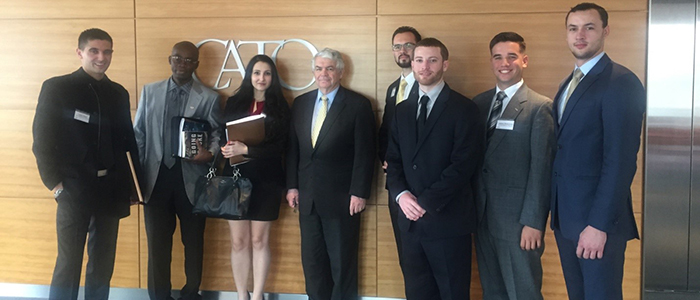ESU Economic Students Attend Cato Institute

Posted by: admin on November 19, 2015, No Comments
With the encouragement and support of the ESU department of economics and finance and the dean of the College of Business and Management, a cross section of economics students attended the Cato Institute’s 33rd Annual Monetary Conference in Washington, D.C. on November 12.
The Cato Institute was established in 1977 as a public policy research organization and is committed to the principles of individual liberty, limited government, free markets and peace. Its scholars and analysts conduct independent, nonpartisan research on a wide variety of policy issues that are relevant to monetary policy.
Though the expression “Cato” can innocently or easily be misunderstood as an acronym, it typifies an endearment to a series of essays on liberty and limited government that were published in 18th century England. In keeping with a tradition of independence and libertarian ideals, the Institute accepts no government funding.
The annual conference presented robust analyses of the divergent and shifting challenges that confront policy makers who design and implement monetary policy in the U.S. and the rest of the world. Prominent issues on the program included monetary policy rules and discretion, inflation and disinflation, and the problems that are associated with harnessing the maximum amount of information that is required for the Federal Reserve, the central bank of the U.S., and other central bankers to ensure stable prices and full employment.
The students were able to acquire valuable information and/or interact with very prominent economists who had spent a considerable amount of time researching and implementing monetary policy as members of Federal Reserve Boards or as members of international banking institutions. By raising pertinent questions during informal conversations with some prominent presenters, the students were provided an excellent opportunity to extend their intellectual curiosity beyond their immediate classroom environments.
Some of the students were particularly fortunate to meet with Professor John B. Taylor, a Mary and Robert Raymond professor of economics at Stanford University, whose influential work on monetary policy rule has tacitly or pointedly influenced the implementation of monetary policy in the U.S. and several countries of the world where there is a willingness to guarantee the independence or autonomy of central banks. He proposed a simple rule for monetary policy that is now famously regarded as the Taylor Rule:
Nominal Fed Funds Rate = Inflation + 2 + 0.5 (Inflation-2) – 0.5 (GDP gap).
Invariably, all rules are guideposts that are susceptible to adjustments and discretion when circumstances change in a fundamental way. Sudden disruptions (shocks) that reflect fundamental changes naturally generate a time inconsistency problem. The Great Recession of 2007-2008 proved to be no exception to the rule, and the Fed subsequently resorted to quantitative easing (QE), the purchase of long-term assets, inter alia. However, the Taylor Rule constitutes one of the most significant contributions to economic thought in our lifetime. It is realistically poised to influence discussions about monetary policy and challenges into the distant future.
For more information contact Pattabiraman Neelakantan, Ph.D., professor and chair of economics and finance, at 570-422-3002.




